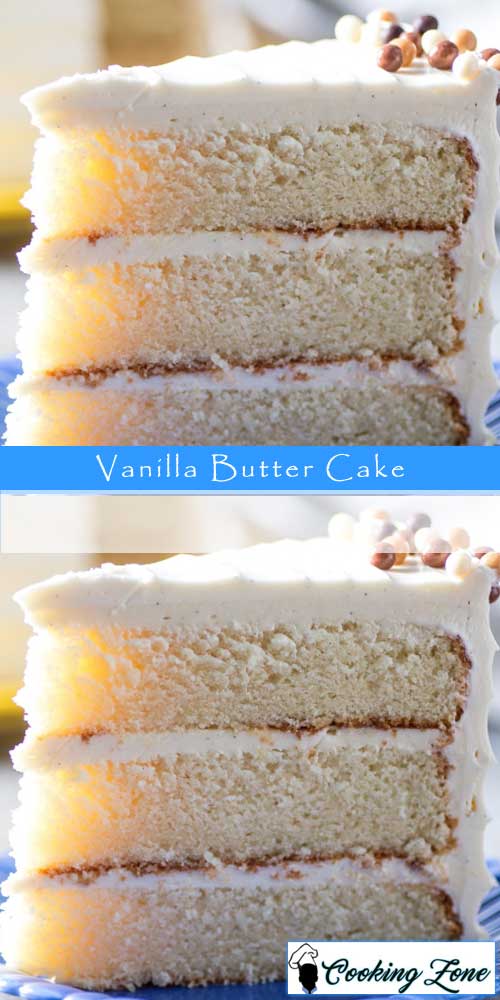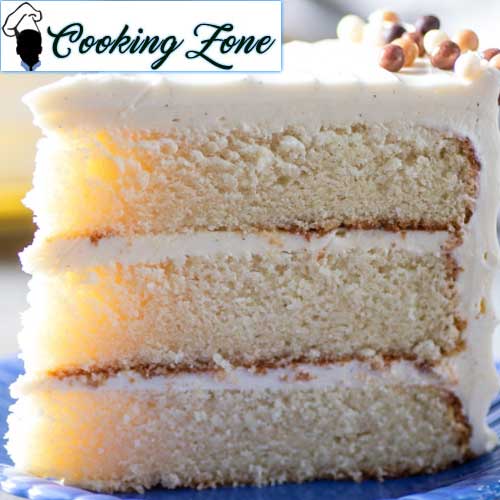The success of most any cake depends on the temperature of your ingredients. Too warm and the batter will be thin, which will make a cake that’s gummy and dense. Too cold and the batter will be heavy and curdled, giving the cake a coarse and muffin-like crumb. These problems can be avoided altogether simply by paying attention to the temperature of your butter, milk, and eggs. With those details squared away, it’s easy to whip up a simple three-egg vanilla cake that’s fluffy, tender, and perfectly moist.

How To Make Vanilla Butter Cake?
Why It Works
- At 60°F (16°C), butter is soft but pliable, ideal for aeration, giving the cake a fine, even crumb.
- Butter and sugar warm to about 65°F (18°C) after creaming, so that’s the best temperature for the eggs and milk.
- Vanilla extracted with both water and alcohol, such as Watkins, provides an unusually robust flavor in baked goods.
- Baking in tall, straight-sided aluminum pans will encourage a level rise with a pale and tender crust.
- Leveling the cakes helps them more readily absorb flavor and moisture from the vanilla frosting.
Ingredients
- For the Cake:
- 16 ounces plain or toasted sugar (about 2 ¼ cups; 455g)
- 4 ½ teaspoons baking powder
- 2 teaspoons (8g) Diamond Crystal kosher salt; for table salt, use about half as much by volume or the same weight
- 8 ounces unsalted butter (16 tablespoons; 225g), soft but cool, about 60°F (16°C)
- 3 large eggs, brought to about 65°F (18°C)
- ½ ounce vanilla extract (about 1 tablespoon; 15g)
- 16 ounces whole milk (about 2 cups; 455g), brought to about 65°F (18°C)
- 16 ounces all-purpose flour (about 3 ½ cups, spooned; 455g)
Directions
-
For the Cake: Adjust oven rack to lower-middle position and preheat to 350°F (180°C). Lightly grease three 8-inch anodized aluminum cake pans and line with parchment. If you don’t have three pans, it’s okay to bake the cakes in stages, the batter will keep at room temperature until needed.
-
In the bowl of a stand mixer fitted with the paddle attachment, combine sugar, baking powder, salt, and butter. Mix on low speed to roughly incorporate, then increase to medium and beat until fluffy and light, about 5 minutes. About halfway through, pause to scrape the bowl and beater with a flexible spatula.
-
With the mixer still running, add the eggs one at a time, letting each fully incorporate before adding the next, then dribble in the vanilla. Reduce speed to low and sprinkle in about 1/3 of the flour, then drizzle in 1/3 of the milk. Repeat with remaining flour and milk, working in thirds as before.
-
Scrape the bowl and beater with a flexible spatula, and resume mixing on medium speed for about 3 seconds to ensure everything is well combined. The batter should look creamy and thick, registering between 65 and 68°F (18 and 20°C) on a digital thermometer. (Significant deviation indicates ingredients were too warm or too cold, which can lead to textural problems with the cake.)
-
Fold batter once or twice from the bottom up with a flexible spatula, then divide evenly between prepared cake pans (about 20 ounces or 565g if you have a scale). Stagger pans together on the oven rack, and bake until puffed, firm, and pale gold, about 32 minutes. If your oven has very uneven heat, pause to rotate the pans after about 20 minutes. Alternatively, bake two layers at once and finish the third when they’re done.
-
Cool cakes directly in their pans for 1 hour, then run a butter knife around the edges to loosen. Invert onto a wire rack, peel off the parchment, and return cakes right-side-up (covered in plastic, the cakes can be left at room temperature for a few hours). Prepare the buttercream.
-
For the Crumb Coat: Level cakes with a serrated knife and set the scraps aside for snacking. Place one layer on a heavy cast iron turntable. If you like, a waxed cardboard cake round can first be placed underneath, secured to the turntable with a scrap of damp paper towel. Top with exactly 1 cup buttercream, using an offset spatula to spread it evenly from edge to edge. Repeat with the second and third layers, then cover the sides of the cake with another cup of buttercream, spreading it as smoothly as you can. Refrigerate cake until the buttercream hardens, about 30 minutes.
-
To Finish: Rewhip remaining buttercream to restore its creamy consistency, then use to finish and decorate the chilled cake as desired. Let the cake sit at room temperature for at least an hour before serving, otherwise it will be too cold inside. Cut with a chef’s knife to serve, and cover the exposed edges with leftover buttercream to keep the cake moist. Under a cake dome, the cake will keep for 3 days at room temperature.

